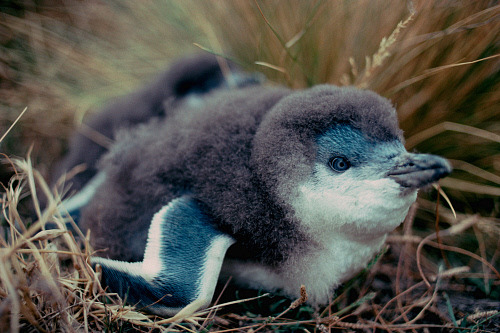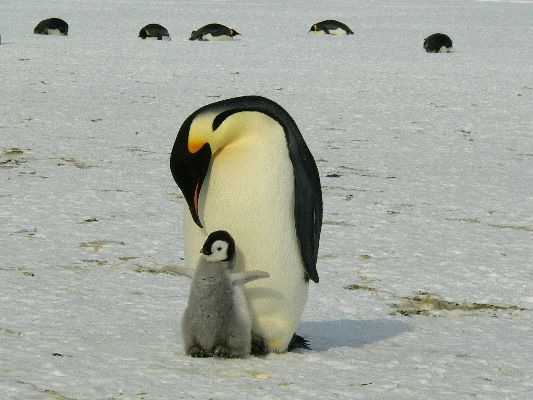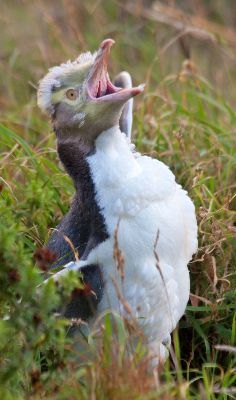Broken Homes And Hearts: The Little Blue Penguins Of Waiheke Island
We need to prioritise our wildlife if we want to protect it. It seems so obvious, and yet economic motives nearly always trump ecological integrity.
The work on a planned marina at Kennedy Point on Waiheke Island where the kororā (little blue penguin) nest is a case in point. Developers were to begin the work this week by removing some rocks at the base of a wall where the kororā burrow. Due to the courage and fortitude of a protest group called Save Kennedy Point (SKP) the destruction of the penguin's home has been put on ice -at least temporarily.
The protestors kayaked and snorkelled around the bay to prevent the construction workers beginning the destruction of the wall.
And yet they may still lose this battle, and the penguins may lose their burrows. The Auckland Council granted Kennedy Point Marina resource consent in 2016. SKP have gone to the Environment Court, the High Court and the Court of Appeal to get the consent overturned. They were unsuccessful and are now waiting on a decision by the Supreme Court to overturn the High Court ruling so they can go back to the Environment Court.
There quite simply is no Ying without Yang. If you want to construct something it often involves the destruction of something else. Or to put it another way, to make an omelette you have to break a few eggs. In the case of Kennedy's Point, we may be breaking a few metaphorical eggs of the kororā to construct a marina for boats and people to enjoy. And for developers to get rich.
The plight of the kororā is not rocket science, but it is ecological science which is arguably much more important for us to get our heads around. And our hearts. Because we need to care for the environment; see it's worth in ecological, spiritual, cultural and aesthetic terms and not just dollar signs.
The kororā, is a Tāoka (Treasured) Species and a threatened native species. It is the smallest penguin species on the planet.

Developers have reportedly hit back at the protestors saying that they are ‘committed to protecting the birds’. They contacted Waiheke Native Bird Rescue general manager Karen Saunders asking her to remove penguins on site the following day. She wasn’t having it, calling the conversation ‘repulsive’. Saunders made the point that the destruction of penguin habitat was illegal under the Wildlife Act.
Saunders also said it was animal cruelty – which it is. The rock wall contains 27 burrows – and these are the penguins’ homes. The burrow is extremely important to the kororā. It is where they nest and bring up their young. Kororā are faithful to their home site and will often nest only metres from where they hatched.
According to Saunders, the Waiheke penguins’ welfare is at risk as there has been a late breeding season. Pairs that were unsuccessful the first time may have gone into second time breeding mode and may have had a fledgling recently. They will then go out and eat for two to three weeks and then come home to moult. Basically, if their burrow has been destroyed then they will be cold and homeless and stressed. When they moult they cannot swim and so are especially vulnerable.
The kororā is easily disturbed by humans. The Department of Conservation (DOC) says that they are declining in numbers in part due to interference from humans. They get caught in set nets. They are vulnerable to climate change and ocean pollution. They are also declining due to habitat destruction and attacks by introduced species such as dogs and cats.
It’s madness. And the kororā are just one of many species of penguins and seabirds more broadly speaking that are declining worldwide because of human activity. Birdlife international reports that 10 of the world’s 18 penguin species are endangered. Having taken millions of years to adapt to some of the most challenging environments on Earth, it has taken humans less than one hundred years to bring them to their knees (or flippers).

The Hoiho (yellow eyed penguin) is endemic to New Zealand’s South Island and sub-Antarctic islands. It may be the world’s rarest and most ancient of all penguins numbering around 4000. Their devastating decline since the 1980s has been mostly caused by a corresponding decline in important fish prey such as red cod. Red cod have declined due to a combination of increasing ocean temperature (climate change) and commercial fishing since the mid-1990s. These penguins also suffer from being caught in set nets.

Sadly hundreds of emaciated seabirds are now starving in New Zealand as young birds are finding it hard to find enough fish in the oceans to eat. Kaikoura Wildlife Rescue deals with hundreds of starving birds and has to use donations of fish past its use-by-date from shops. They also say the starvation is caused by warming global temperatures and over-fishing,
Taken as a whole, seabirds are experiencing steep declines, making them one of the most threatened group of vertebrates globally.
A recent study by scientists entitled ‘Threats to seabirds: a global assessment’, argues that the top threats to seabirds include invasive species, bycatch and climate change. The report also says that overfishing, hunting/trapping and disturbance are other threats.
Penguins were identified in this study as one of the seabird groups who were experiencing both terrestrial and marine threats to their survival. They face extinction, and it’s our fault.
We should not be building a marina right where they live. It’s not only disrespectful, but blatantly ignores the dire situation penguins and other seabird species currently face.
Decline and threats to seabirds are just part of the story. The WWF Living Planet Report 2020 revealed a global species loss of 68 per cent in less than 50 years. This includes mammals, birds, fish, amphibians and reptiles. The report says that 70 per cent of this loss has been caused by conversion of land for agriculture. WWF says the findings of the report are clear: “Our relationship with nature is broken”.
Yes indeed. The destruction of kororā habitat to make room for a marina is indeed a symptom of our broken relationship with nature.
In my lifetime of 53 years on this planet there has been so much biodiversity loss. The planet is now at the start of the sixth great extinction in history. The kind of grief this causes me, and others like me is monumental. It is like someone is turning off the lights, nature is dimming, and life is fading away. This is the apocalypse. It hurts.
The term for this kind of pain was coined in 2018 and is called ecological grief. We feel it when we have a close relationship with the natural environment.
So let’s all stand up for the kororā and every single animal that remains threatened by humans.
The time is now.


 Gordon Campbell: On More Threats To Democracy From David Seymour
Gordon Campbell: On More Threats To Democracy From David Seymour Martin LeFevre - Meditations: Good Does Not Fight Evil, But Stands Firm And Dispels It
Martin LeFevre - Meditations: Good Does Not Fight Evil, But Stands Firm And Dispels It Binoy Kampmark: Bitter Harvests - The Gaza Ceasefire
Binoy Kampmark: Bitter Harvests - The Gaza Ceasefire Binoy Kampmark: Situation Critical - UNRWA And Its Continued Operations
Binoy Kampmark: Situation Critical - UNRWA And Its Continued Operations Martin LeFevre - Meditations: Waiting For Trump - How Bad Will It Be?
Martin LeFevre - Meditations: Waiting For Trump - How Bad Will It Be? Ramzy Baroud: The Gaza Genocide - The Fall Of Israel’s Immunity
Ramzy Baroud: The Gaza Genocide - The Fall Of Israel’s Immunity
